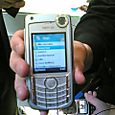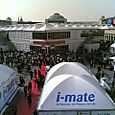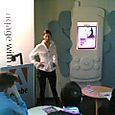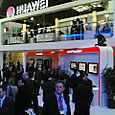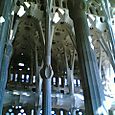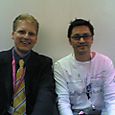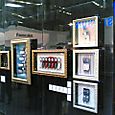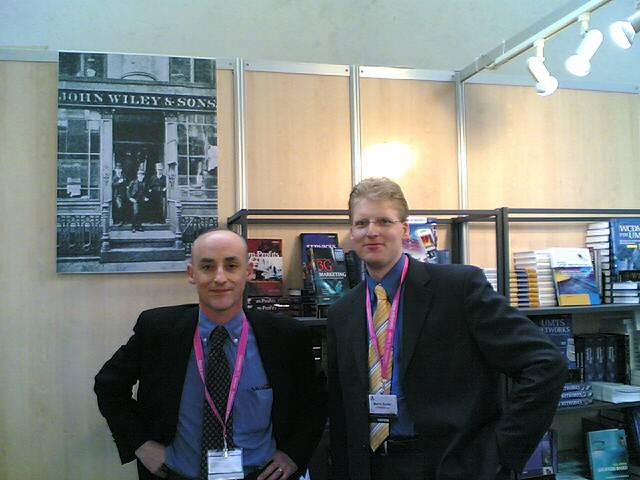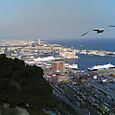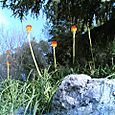
Last year, LTE mobile devices where still the of the size of a cabinet. At this year’s 3GSM / Mobile World Congress the hardware has now shrunken to the size of a PC motherboard. The picture on the left shows a LTE mobile with 2×2 MIMO from LTE which was used to stream several videos at a speed of 30+ MBit/s via a LTE prototype base station supplied by Nortel. So by next year we should see first PC-card prototypes. Things are moving ahead.
Category: 3GSM
TelecomTV coverage of the Mobile World Congress
In case you haven’t made it to Barcelona for this year’s 3GSM / Mobile World Congress or in case you would like to see what you have not seen while being there, Telecom TV has put the shows they produced during the event on the web. Here’s the wrap up of day four:
As reported last week I also very much enjoyed the CTO panel which I watched live. For all their other productions during the MWC take a look here.
The 3GSM Gem in Barcelona: Intel and Motorola’s Live WiMAX network
I had to hold back with this blog entry a bit because I wanted to get permission first to write about what I would say was the most interesting demo I’ve been invited to during the 3GSM / Mobile World Congress:
 Lots of WiMAX demos where shown at this years congress and it’s good to see that 802.16e mobile devices have now reached PC-card card sizes and are close to general availability. It’s also nice to see that when the antenna is just a couple of meters away you can see data rates beyond 10 MBit/s. However, that tells you only little about how the system performs in practice when the base station antenna is a couple of blocks away on top of a building and there is interference from neighboring base stations. To go the extra step, Intel and Motorola have teamed up to show how their kit works in a real environment during this years show.
Lots of WiMAX demos where shown at this years congress and it’s good to see that 802.16e mobile devices have now reached PC-card card sizes and are close to general availability. It’s also nice to see that when the antenna is just a couple of meters away you can see data rates beyond 10 MBit/s. However, that tells you only little about how the system performs in practice when the base station antenna is a couple of blocks away on top of a building and there is interference from neighboring base stations. To go the extra step, Intel and Motorola have teamed up to show how their kit works in a real environment during this years show.
Network Setup
In just a few days, Intel has put up four Motorola WiMAX base stations on rooftops in central Barcelona which were connected to the core network via 50 MBit/s microwave backhaul equipment from Dragonwave. Each base station was equipped with 3 sectors, each on its own 10 MHz channel in the 2.5 GHz band. In total they had three channels available for the network so each base station used the same set of frequencies. The distance between the base stations was about 2 kilometers which is a bit more then what you would see in an inner city network deployment. They couldn’t choose the sites themselves and had to be happy with what they got. On the upside, there is less interference from neighboring cells then there would be in a public network since there were only 4 cells and thus there is no interference from cells further away.
Indoor Experience
Sitting comfortably in the lobby of a hotel in Central Barcelona, I first had a chat with the technical project manager responsible for the network setup. Very good to have somebody with a technical background to talk to. During our discussion I got a first impression of the network performance as there were two notebooks connected to the network, one via a WiMAX PC-card adapter and the other via a CPE (Customer Premises Equipment) box the size of a DSL or cable modem. Despite sitting in the ground floor lobby, the base station being a couple of rooftops away on the other side of the hotel, the probably heat insulated and RF absorbing windows and just using the built in antennas of the devices we still got a data rate exceeding 2 MBit/s via both the CPE and the PC-card adapter. Note that both were SISO (Single Input Single Output) devices. As even this speed is far beyond what you can make use of while surfing the web we streamed a couple of video streams being sent live from WiMAX connected vehicles touring the city. The resolution of the stream was around 320×240 pixels and with a frame rate of 30 fps and the video streams were crisp and clear. One of the notebooks also had an engineering monitor software package on it to observe lower layer performance of the PC card and it was interesting to see how the card goes through the different modulation and coding schemes from QPSK to 64-QAM as reception conditions changed.
Outdoor Experience

Later on we went outside and used Segways to speed up and down the streets with a notebook attached to it to see how the network copes with mobility. Again the video stream performance was flawless and we streamed a U.S. TV station over the Internet which is quite bandwidth hungry. But even this does not require a bandwidth beyond 5 MBit/s which was obviously not the limit of the network. When asked what the highest throughput is that can be observed in the network I was told that it is around 13 MBit/s with 64-QAM and about 1.5 MBit/s at the cell edge with QPSK ½ modulation and coding despite the fact that the cells are too far away from each other. Interesting numbers showing the direction in which we are headed once 2×2 MIMO is added and proper cell sizes are used.
Here’s a video taken and produced by Marc Wallis and Michael Ambjorn of Intel/Motorola respectively:
(copyright by M. Wallis / M. Ambjorn of Intel/Motorola)
Conclusion
I came away very impressed from the demo as the speeds were amazing. We didn’t loose the connection to the network even once during the one and a half hours sitting in the hotel and touring the city. That says a lot about the software stability of the PC-card and the network. Thanks a lot to Intel for the VIP tour invitation it was definitely the best demo I have seen during the Congress.
3GSM / MWC: On the way

Like every February the wireless community is gathering at the 3GSMWorldCongress (3GSM), now renamed to Mobile World Congress (MWC), to meet, exchange ideas and to see new stuff. For the 7th time in a row I couldn’t resist the call and will join the frenzy.
The picture on the left shows my blogging equipment for this year. As in the past I will keep you up to date before, during and after the show on my blog, so make sure to check regularly. The Bluetooth keyboard works with both the Nokia N93 and the N800 and I will put both devices to good use. The N93 is ideal for real time blogging, for uploading pictures to Flickr and videos to YouTube. The N800 with the bigger screen is ideal to fine tune the blog entries and to make sure my videos posted to YouTube end up on the blog as well.
It’s not only the congress and exhibition itself but also the many things that are happening around it that make this week so unique. I’ll be at the Mobile Sunday on Sunday evening, at the Mobile Monday Global Peer Awards on Monday afternoon and the Mobile Jam session on Tuesday afternoon. All events are organized by Rudy de Waele and I wonder if the man will sleep in the next 10 days… You can find an overview of side events here.
Despite being organized by the GSM Association the congress has been officially opened this year to other (non 3GPP) wireless technologies, hence the somewhat awkward name change to Mobile World Congress. Last year some first WiMAX demos were seen here and there but nothing really impressive. This year I expect that things have changed and I am looking forward to a couple of WiMAX demos with real networks and real devices.
I am also looking forward to see the latest mobile device chipset hardware. Intel has decided it wants a place on mobile devices and it will be interesting to see if they have more to show than just a couple of nice whitepapers and prototypes. ARM, the incumbent processor design house for mobile devices has also not slept and I am looking forward to talk with them about their latest mobile device processor, the ARM Cortex.
One layer above there’s Symbian with Nokia’s S60 and Sony Ericsson’s UIQ on top of it, Windows mobile and a number of promising Linux initiatives such as Android and Maemo. Apple’s probably not there but they wouldn’t get the same applause at such a show compared to an Apple only event anyway. And while their OS is closed I don’t really mind, either.
While a couple of years ago the exhibition was mostly around network infrastructure and mobile phones, application developers have become much more important in recent years. I expect the trend to continue this year and can’t wait to discover cool new startups. In this respect the name change from 3GSM to MWC also makes sense because applications don’t really care about the network below.
Network wise I was pretty happy with the public 3G network performance on the exhibition ground in previous years. With 30.000+ people being at the exhibition simultaneously, most with the latest gear, I am looking forward to see if the infrastructure can cope. It is as always the ultimate capacity test despite the fact that most exhibitors have a fixed line Internet connection in addition.
Mobile Jam Session the latest addition to the 3GSM side event Wiki
Three weeks to the 3GSM / MobileWorldCongress and the side events Wiki starts to fill up! The Mobile Jam Session for developers is one of the latest the latest additions. Conceived by Rudy de Waele and Caroline Lewko the half day event is geared towards developers in the mobile space. Instead of passive participation the concept forsees active partcipations by all attendees. I imagine it will be highly ad-hoc and inspiring. I am looking forward to it very much. For details and registration head over to their web page.
For other events, get togethers and parties see the 3GSM Side Event Wiki. All pages can be edited by anyone. So if you hear of something interesting, you can easily and quickly add it to the pages.
3GSM: From Skype to Chinese companies
There are many amazing things to see at the 3GSM congress that don´t make it to the big press feed. For me, they are even more interesting then those who do.
Pick number one today is Skype on mobile phones. Lots of talk about it already but nobody points out that you can see a running prototype on the Nokia stand if you ask for it. Oh, how I am waiting for that application in combination with the new Nokia N80. On the Nokia stand it´s shown on the 6680 (see picture 1), looks like a S60 3rd edition version is not yet available.
I am sure you´ve seen it on other blogs already, Anina is at the show and demos her Flash application on a 6630 (see picture 3). Interesting application, and a very good presentation.
While Chinese companies such as Huawei and ZTE have so far been only on the sidelines at the congress, they are right there in the main hall with the other big players. As you can see on picture 4, lot´s of people on their stand this year compared to only a trickle last year.
Off I go, last day of the show and still so many things to see. I´ll keep you posted!
3GSM: Business and Pleasure
In contrast to Cannes there are so many things to see in Barcelona in addition to the technology at the event which really is a huge plus. So we took the liberty for some sightseeing and relaxation and went to Gaudi´s Sagrada Familia cathedral (see pictures one and two).
In the evening another highlight of the day was the gathering of the Mobilist in the Hotel Ritz, organized by Rudy DeWaele. "It´s time to arrive before you are already there" I can read on the Treo advertisment just outside. That quite fits to that gathering. I met quite a number of people whom I only met via their blogs before and communication was instant. Thanks so much Rudy, I had many good conversations and surely met some people that I will keep in touch with. On picture three that´s Rudy on the left and David Mery of Symbian on the right
A Scottsman is playing a pipebag outside at the entrance of hall 2, so I feel the urge to join the masses again to discover, discover, discover…
3GSM: Picks of Day 1
So many things to see at the congress and so many interesting discussions that it´s easy to loose track if you don’t take notes. Here are my picks of the day:
As promissed on their blog, some of the bloggers of s60.com are in Barcelona for the week and I had the luck to talk to Jouni Juntunen, aka MKTMAN at the s60 booth (picture 1). Great discussions on S60 features (of course), Nokia policy towards blogging, the competing products and great demos at the booth.
This is the third year in a row I visited the Kineto booth who work on the integration of cellular and Wifi. The technology is called UMA (Unlicensed Mobile Access) and basically replaces the GSM air interface layer with Wifi. This year they seem closer than ever to reaching their goal as a number of mobile phone manufacturers such as Nokia have announced GSM/UMTS/Wifi phones. But these days I think they will have strong competition from SIP and Skype, especially on phones such as the Nokia N80. Their advantage: They don´t bind the user to the cellular operator as UMA does and thus could potentially be cheaper. For the user, competition is good and will have a positive influence on prices.
NTT DOCOMO of Japan combines art and technology on their booth. Picture 2 shows some mobile phone art. At the booth they demo 3G video streaming vs. HSDPA streaming at 2 MBit/s. Big difference! And they have technical experts on the stand to discuss their view of wireless evolution: 1 GBit/s, 100 MHz channel bandwidth (compare to 5 MHz of UMTS today), QPSK and 16QAM modulation, OFDM downlink, CDMA uplink, 4×4 Mimo. Heavy stuff, but speed has it´s price.
My last pick of the day is Picsel. They have a great eMail program and file attachment handler for S60 (and Java for other phones) that removes file attachements and downloads a mobile adapted version of the document. Very fast, very slick and reduces the amount of data you have to download or store on the phone.
